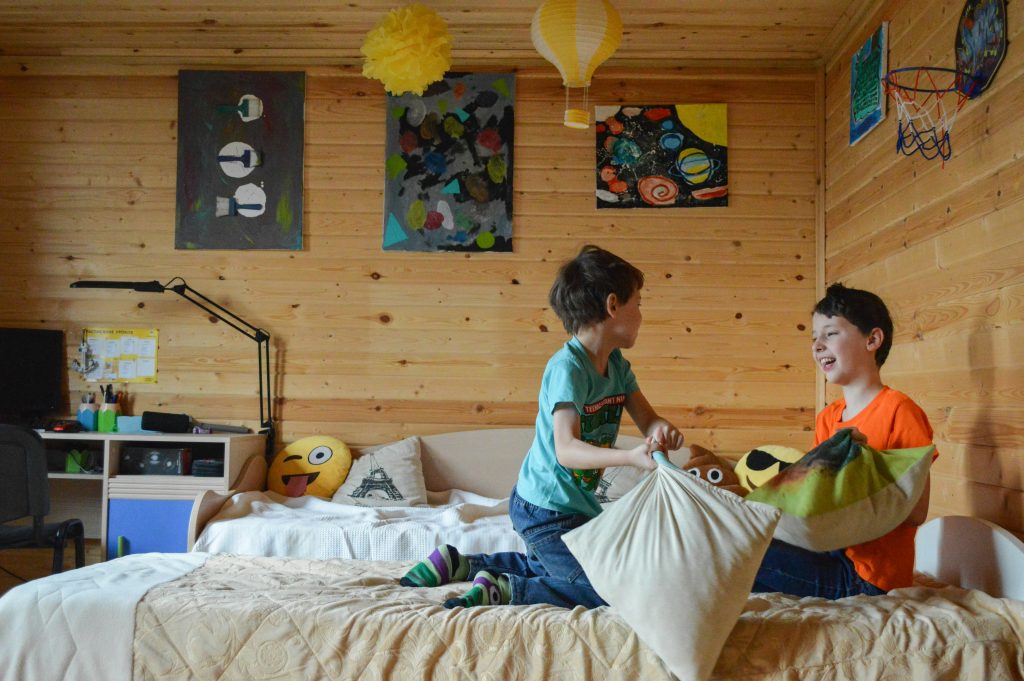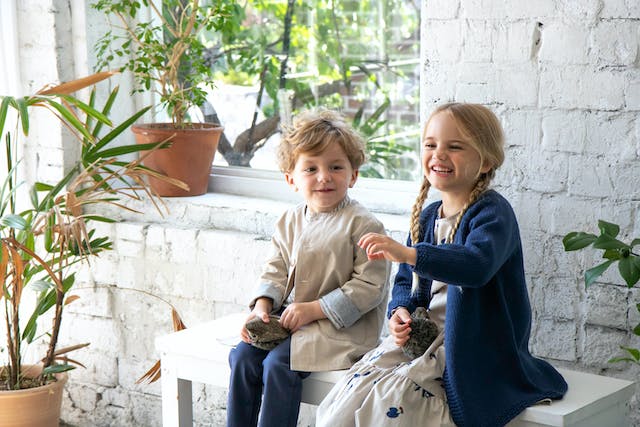Get Creative with Your Kids\’ Wardrobe: DIY Clothing Ideas for Fashionable Little Ones
DIY clothing for kids is a wonderful way to encourage creativity and individuality, while also saving money and teaching valuable skills. When children are involved in the process of creating their clothes, they have the opportunity to express their unique style and personality. DIY projects also provide a sense of accomplishment and pride, as children can wear and show off their creations. Additionally, making clothes at home allows parents to save money by repurposing old garments or finding affordable materials. Finally, DIY clothing projects teach children important skills such as sewing, upcycling, and design, which can be valuable throughout their lives.
Clothing Ideas for Fashionable Little Ones

Upcycling Old Clothes: Turning Trash into Treasure
One of the most popular DIY clothing techniques is upcycling, which involves repurposing old clothes to create new and unique pieces. This not only saves money but also reduces waste and promotes sustainability. There are many ways to upcycle old clothes, such as turning a t-shirt into a dress or transforming jeans into shorts. By using basic sewing skills and a little creativity, parents can create one-of-a-kind garments for their children.
For example, an old button-up shirt can be transformed into a trendy dress by removing the sleeves and adding a gathered skirt. A pair of worn-out jeans can be cut into shorts and then embellished with patches or embroidery for a personalized touch. The possibilities are endless when it comes to upcycling old clothes, and it’s a great way to give new life to items that would otherwise end up in the trash.
Personalizing with Patches and Pins: Adding Flair to Basic Pieces
Another fun way to DIY clothing for kids is by adding patches and pins to basic pieces. This allows children to personalize their clothes and make them truly unique. Patches can be sewn or ironed onto jackets, jeans, or backpacks, while pins can be attached to hats, shirts, or bags. This simple technique allows children to express their interests and hobbies through their clothing.
Parents can help their children choose patches and pins that reflect their personalities, such as ones featuring their favorite animals, sports teams, or characters. This not only adds flair to basic pieces but also encourages children to embrace their individuality and express themselves through fashion. Additionally, patches and pins can easily be removed or changed, allowing for endless possibilities and creativity.
Tie-Dyeing Techniques: Creating One-of-a-Kind Patterns
Tie-dyeing is a classic DIY technique that never goes out of style. It’s a fun and easy way to create vibrant and unique patterns in clothing. To tie-dye clothing, you will need fabric dye, rubber bands, and a plain white garment. There are various tie-dyeing techniques to choose from, such as the spiral, bullseye, or crumple method.
To create a spiral pattern, start by pinching the center of the fabric and twisting it into a spiral shape. Secure the fabric with rubber bands in a star pattern, then apply different colors of dye to each section. For a bullseye pattern, fold the fabric accordion-style and secure it with rubber bands at regular intervals. Apply different colors of dye to each section. The crumple method involves randomly scrunching up the fabric and securing it with rubber bands before applying dye.
Tie-dyeing is a great way for kids to experiment with color and pattern. They can create their own unique designs by choosing different colors and techniques. It’s a fun activity that allows children to express their creativity and create one-of-a-kind pieces of clothing.
Screen Printing at Home: Designing Custom Graphic Tees
Screen printing is another DIY technique that allows you to design custom graphic tees at home. While it may seem intimidating at first, it’s quite simple with the right materials and instructions. To screen print at home, you will need a screen printing kit, which typically includes a screen, squeegee, and fabric ink.
To create a custom graphic tee, start by designing your image or text on a computer and printing it onto a transparency sheet. Attach the transparency to the screen using tape or adhesive. Apply fabric ink to the screen and use the squeegee to evenly distribute the ink over the design. Carefully lift the screen to reveal your printed design on the fabric.
Screen printing allows children to create their unique designs and express their creativity. They can design shirts featuring their favorite characters, quotes, or artwork. It’s a fun and rewarding activity that allows kids to wear their creations and show off their artistic skills.
Embroidery for Beginners: Adding a Touch of Handmade Charm
Embroidery is a beautiful and timeless technique that can add a touch of handmade charm to clothing. It involves stitching decorative designs onto fabric using colored threads. While embroidery may seem complex, there are many beginner-friendly stitches that children can learn and practice.
To embroider clothing, you will need an embroidery hoop, embroidery floss, needles, and fabric. Start by securing the fabric in the embroidery hoop to keep it taut. Choose a design or pattern and transfer it onto the fabric using a water-soluble pen or transfer paper. Thread your needle with embroidery floss and begin stitching according to your design.
Embroidery allows children to add their personal touch to clothing by stitching their initials, flowers, or other designs onto garments. It’s a relaxing and meditative activity that can help improve fine motor skills and concentration. Embroidered pieces of clothing also make thoughtful and unique gifts for friends and family.
Sewing Projects for Kids: Simple Patterns to Try at Home
Sewing is a valuable skill that can be taught to children at a young age. It not only allows them to create their clothes but also teaches them patience, problem-solving, and attention to detail. There are many easy sewing projects that kids can try at home, such as simple skirts, tote bags, or stuffed animals.
For example, a basic elastic waist skirt can be made by sewing two rectangles of fabric together and adding an elastic band at the waist. A tote bag can be created by sewing two rectangles of fabric together and adding handles. Stuffed animals can be made by cutting out two identical shapes from fabric, sewing them together, and stuffing them with filling.
Sewing projects for kids are a great way to introduce them to the world of DIY fashion. They can learn basic sewing techniques and create their unique pieces of clothing or accessories. Sewing also promotes creativity and problem-solving skills, as children have to figure out how to construct their projects and make them functional.
Refashioning Thrift Store Finds: Finding Gems in Secondhand Shops
Thrift stores are treasure troves of unique and affordable clothing that can be refashioned into stylish pieces. By shopping at thrift stores, parents can find gems that can be transformed into one-of-a-kind garments for their children. This not only saves money but also promotes sustainability by giving new life to pre-loved items.
To find gems in thrift stores, it’s important to have an open mind and be willing to think outside the box. Look for items with interesting patterns or textures that can be repurposed or altered. For example, a large men’s shirt can be transformed into a trendy dress by taking in the sides and adding a belt. A vintage skirt can be shortened or dyed to give it a modern twist.
Refashioning thrift store finds allows children to have unique and stylish clothing without breaking the bank. It also encourages creativity and resourcefulness, as they have to think of ways to transform and repurpose items. By shopping at thrift stores, parents can teach their children the value of recycling and reusing, while also supporting local businesses.
DIY Accessories: Adding the Finishing Touches to Any Outfit
Accessories are the finishing touches that can elevate any outfit. DIY accessories allow children to add their own personal style and flair to their clothing. There are many ideas for DIY accessories that kids can try, such as making friendship bracelets, beaded necklaces, or fabric headbands.
For example, friendship bracelets can be made by knotting colorful threads together in various patterns. Beaded necklaces can be created by stringing beads onto a cord or wire and adding a clasp. Fabric headbands can be made by cutting a strip of fabric and sewing or gluing the ends together.
DIY accessories not only allow children to express their creativity but also teach them basic crafting skills. They can experiment with different materials, colors, and techniques to create accessories that reflect their unique style. Additionally, making their accessories gives children a sense of pride and accomplishment when they wear them.
Sustainable Fashion: Teaching Kids the Importance of Recycling and Reusing
Sustainable fashion is an important concept that teaches children the importance of recycling and reusing. By DIYing clothing and accessories, parents can instill in their children the value of reducing waste and making conscious choices when it comes to fashion. Sustainable fashion is all about making thoughtful decisions about what we wear and how it’s made.
To teach kids about recycling and reusing, parents can involve them in the process of repurposing old clothes or shopping at thrift stores. They can explain the environmental impact of fast fashion and the benefits of choosing sustainable options. By engaging children in conversations about sustainability, parents can help them develop a lifelong appreciation for ethical fashion practices.
The benefits of sustainable fashion are numerous. It reduces waste, conserves resources, and supports local businesses. By teaching children about sustainable fashion, parents are not only helping to protect the environment but also empowering their children to make conscious choices and become responsible consumers.
Encouraging Creativity and Individuality through DIY Fashion
In conclusion, DIY clothing for kids is a great idea for many reasons. It encourages creativity and individuality, as children have the opportunity to express their unique style and personality. DIY projects also save money by repurposing old clothes or finding affordable materials. Additionally, DIY fashion teaches valuable skills such as sewing, upcycling, and design.
There are many techniques and projects that parents and children can try at home. Upcycling old clothes allows for the transformation of trash into treasure. Personalizing with patches and pins adds flair to basic pieces. Tie-dyeing creates one-of-a-kind patterns. Screen printing allows for custom graphic tees. Embroidery adds a touch of handmade charm. Sewing projects teach valuable skills. Refashioning thrift store finds give new life to pre-loved items. DIY accessories add the finishing touches to any outfit. And sustainable fashion teaches kids the importance of recycling and reusing.
By encouraging creativity and individuality through DIY fashion, parents can help their children develop important skills, express themselves through clothing, and make conscious choices about what they wear. DIY fashion is not only fun and rewarding but also promotes sustainability and empowers children to embrace their unique style. So why not give it a try? The possibilities are endless when it comes to DIY clothing for kids!

